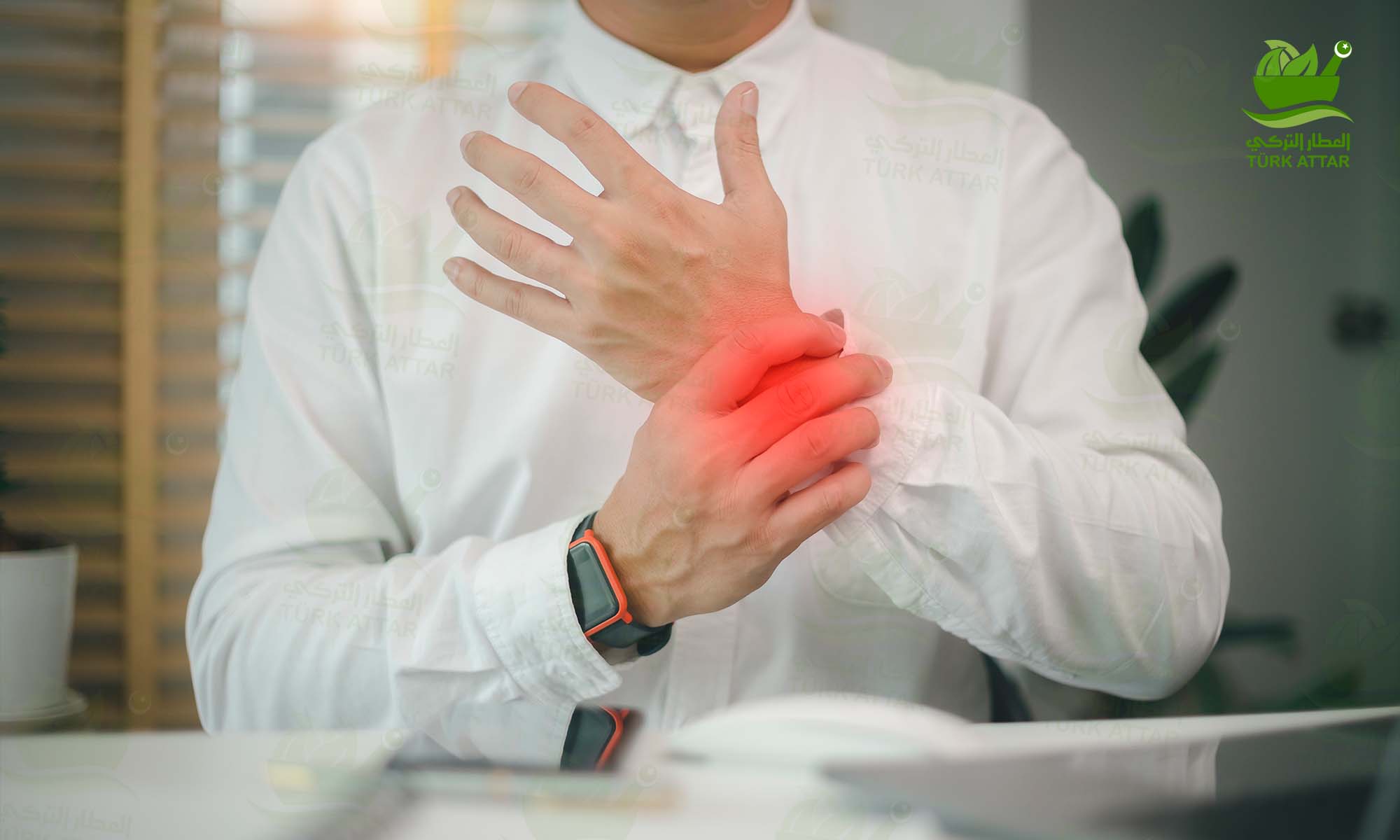
الروماتيزم الالتهابي المعروف أيضًا باسم التهاب المفاصل الروماتويدي: هو اضطراب التهابي مزمن يمكن أن يؤدي هذا الاضطراب إلى إتلاف مجموعة متنوعة من أجهزة الجسم لدى بعض الأفراد بما في ذلك الجلد والعينين والرئتين والقلب والأوعية الدموية.
التهاب المفاصل الروماتويدي
إن الاعتقاد بأن الطقس شديد الحرارة أو البرودة يسبب التهاب الروماتيزم لا يعكس الحقيقة حيث يحدث التهاب المفاصل الروماتويدي بسبب اضطراب في جهاز المناعة الذاتية ويحدث عندما يهاجم الجهاز المناعي للفرد عن طريق الخطأ أنسجة الجسم وخاصة أنسجة المفاصل.
على عكس التلف المباشر الناتج عن الاهتراء أثناء عملية التكلس, هناك نوع آخر من الروماتيزم هو التهاب المفاصل الروماتويدي حيث يؤثر التهاب المفاصل الروماتويدي على غشاء المفصل للفرد ويسبب تورمًا مؤلمًا يمكن أن يؤدي إلى تآكل العظام وتشوه المفاصل في المراحل اللاحقة.
التهاب المفاصل الروماتويدي هو حالة يمكن أن يؤدي فيها الالتهاب إلى إتلاف أجزاء أخرى من الجسم وعلى الرغم من أن الأنواع الحديثة من الأدوية قد حسنت بشكل كبير نتائج خيارات العلاج إلا أن التهاب المفاصل الروماتويدي الحاد يمكن أن يتسبب في إعاقة جسدية للأفراد اليوم.
الأسباب:
ما الذي يسبب التهاب المفاصل الروماتويدي (التهاب الروماتيزم)؟
- يحدث التهاب المفاصل الروماتويدي عندما يهاجم الجهاز المناعي للفرد الغشاء الزلالي أو الغشاء الزليلي أو الغشاء المزلق وهو بطانة الأغشية المحيطة بالمفاصل حيث يؤدي الالتهاب الناتج عن هذا الهجوم إلى زيادة سماكة الغشاء الزليلي وبالتالي تدمير الغضاريف والأنسجة العظمية في المفصل, نتيجة لذلك تبدأ الأوتار والأربطة التي تربط المفصل معًا بالضعف والتمدد وبمرور الوقت يفقد المفصل شكله الطبيعي وموقعه الذي يوفر الحركة السلسة.
- على الرغم من أن المهنيين الطبيين لا يعرفون على وجه اليقين سبب هذه العملية إلا أنهم يقولون أن هناك احتمال وجود عامل وراثي.
- وعلى الرغم من أن الجينات لا تسبب التهاب المفاصل الروماتويدي بشكل مباشر إلا أنها يمكن أن تجعل الفرد أكثر عرضة للعوامل البيئية مثل العدوى ببعض الفيروسات والبكتيريا التي يمكن أن تسبب المرض والذي يسبب التهاب الروماتيزم.
- من ناحية أخرى يحدث الروماتيزم غير الالتهابي عادة بسبب نتوء عظمي بسبب تآكل وترقق المفاصل نتيجة الصدمة مثل السقوط أو الحوادث.
ما هي العوامل التي تزيد من خطر الإصابة بالتهاب المفاصل الروماتويدي (الروماتيزم الالتهابي)؟
يلعب جنس الشخص دورًا مهمًا في زيادة خطر الإصابة بالتهاب المفاصل الروماتويدي فالنساء أكثر عرضة من الرجال للإصابة بالتهاب المفاصل الروماتويدي.
يمكن أن يحدث التهاب المفاصل الروماتويدي في أي عمر ولكنه غالبًا ما يظهر لأول مرة في منتصف العمر وهناك أيضًا أنواع من الروماتيزم الالتهابي خاصة بالأطفال.
يجب تشخيص هذه الأنواع وعلاجها مبكرًا لأن خلاف ذلك قد يتسبب في ضرر وتأخر في النمو قد يؤدي إلى إعاقات دائمة لدى الطفل.
الأفراد الذين يعانون من زيادة الوزن أو السمنة وخاصة النساء في سن 55 أو أقل لديهم مخاطر أعلى قليلاً للإصابة بالتهاب المفاصل الروماتويدي من الأفراد الآخرين.
إذا كان هناك فرد مصاب بالتهاب المفاصل الروماتويدي بين أفراد الأسرة الذين تربطه بهم قرابة بالدم فقد يزداد خطر الإصابة بالمرض في الأسرة لأسباب وراثية.
يزيد التدخين بشكل كبير من خطر الإصابة بالتهاب المفاصل الروماتويدي خاصة في الحالات التي يوجد فيها استعداد وراثي للإصابة بالمرض. لقد لوحظ أن الاستمرار في التدخين لدى الأفراد المصابين بالمرض مرتبط بشدة الإصابة بالتهاب المفاصل الروماتويدي.
على الرغم من عدم فهم علاقة المرض بالعوامل البيئية بشكل واضح فقد لوحظ أن التعرض لمواد مثل الأسبستوس أو السيليكا قد يزيد من خطر الإصابة بالتهاب المفاصل الروماتويدي. الأفراد الذين يعملون في أماكن العمل التي تستخدم مثل هذه المواد هم أيضًا أكثر عرضة للإصابة بأمراض المناعة الذاتية الأخرى مثل التهاب المفاصل الروماتويدي.
التهاب المفاصل الروماتويدي (التهاب الروماتيزم) والحمل:
اعتمادًا على نوع الروماتيزم الالتهابي والأضرار التي لحقت بالأعضاء الداخلية ودرجة الضرر قد يكون من غير المناسب الحمل وقد يكون من الممكن السماح بالحمل بعد بعض الفحوصات الطبية خلال الفترات التي لا يتفاقم فيها مرض الأفراد في ظل الظروف العادية. ومع ذلك يجب متابعة هذه العملية عن كثب نظرًا لأن الأمراض الالتهابية الروماتيزمية تعتمد على الجهاز المناعي فقد تتفاقم بعض الأنواع أثناء الحمل بينما قد تختفي الأنواع الأخرى تمامًا. نظرًا للتأثيرات طويلة المدى للأدوية المستخدمة في علاج الروماتيزم الالتهابي، فقد لا يتم استخدامها لفترة من الوقت قبل الحمل.
الروماتيزم الالتهابي ليس مرضا معديًا ولكن بعض المواد التي يمكن أن تنتقل من الأم إلى الطفل قد تسبب بعض السلبيات في الأيام الأولى بعد الولادة ولكن هذا عادة ما يكون حالة مؤقتة. حقيقة أن الوالدين الذين يعانون من التهاب المفاصل الروماتويدي لا يؤدي بشكل حتمي إلى أن الأجيال القادمة ستصاب بالتهاب المفاصل الروماتويدي.
ما هي مضاعفات التهاب المفاصل الروماتويدي (الروماتيزم الالتهابي)؟
يتعرض الأفراد تحت تأثير التهاب المفاصل الروماتويدي لخطر متزايد للإصابة بحالات طبية مختلفة:
هشاشة العظام: يمكن لبعض الأدوية المستخدمة لعلاج التهاب المفاصل الروماتويدي أن تزيد من خطر إصابة الفرد بهشاشة العظام، وهي حالة تضعف العظام وتجعلها أكثر عرضة للكسر.
العقيدات الروماتيزمية: تتكون هذه الكتل الصلبة من الأنسجة بشكل شائع حول المفاصل المضغوطة مثل المرفقين ويمكن أن تحدث هذه العقيدات في أي مكان في الجسم بما في ذلك الرئتين.
جفاف العين والفم: من المرجح أن يعاني الأشخاص المصابون بالتهاب المفاصل الروماتويدي من متلازمة سجوجرن (شوغرن) وهو اضطراب يقلل من كمية الرطوبة في العين والفم.
الالتهابات: يمكن أن يؤدي كل من التهاب المفاصل الروماتويدي نفسه والعديد من الأدوية المستخدمة لمكافحة المرض إلى إضعاف جهاز المناعة مما يؤدي إلى زيادة حالات العدوى الالتهابية الأخرى.
تكوين الجسم غير الطبيعي: الأفراد المصابين بالتهاب المفاصل الروماتويدي تكون نسبة الدهون إلى الكتلة الخالية من الدهون أعلى بشكل عام حتى في أولئك الذين لديهم مؤشر كتلة جسم طبيعي.
متلازمة النفق الرسغي: يمكن أن يضغط الالتهاب الذي يصيب المعصم الناتج عن التهاب المفاصل الروماتويدي على الأعصاب التي تخدم اليد والأصابع مما يسبب عدم الحركة والألم.
مشاكل القلب: عند الأشخاص المصابين بالتهاب المفاصل الروماتويدي يمكن أن يزيد من خطر تصلب الشرايين أو انسدادها والتهاب الكيس المحيط بالقلب.
أمراض الرئة: يتعرض الأشخاص المصابون بالتهاب المفاصل الروماتويدي لخطر متزايد من التهاب وتندب أنسجة الرئة مما قد يؤدي إلى ضيق التنفس التدريجي بمرور الوقت.
سرطان الغدد الليمفاوية: يزيد التهاب المفاصل الروماتويدي من خطر الإصابة بسرطان الغدد الليمفاوية وهي مجموعة من السرطانات التي تتطور في الجهاز اللمفاوي.
الأعراض:
ما هي أعراض التهاب المفاصل الروماتويدي (الروماتيزم الالتهابي)؟
تشمل علامات وأعراض التهاب المفاصل الروماتويدي في المقام الأول المفاصل التي تشعر بألم وتورم وسخونة بالإضافة لذلك فإن تيبس المفاصل والتعب والحمى وفقدان الشهية والتي عادة ما تتفاقم بعد الاستيقاظ في الصباح وبعد الخمول لفترة من الوقت هي أيضًا من بين أعراض التهاب الروماتيزم.
في المراحل المبكرة من المرض يؤثر التهاب المفاصل الروماتويدي على المفاصل الصغيرة بشكل خاص وهي المفاصل التي تربط الأصابع باليدين وأصابع القدم بالقدم.
في المراحل المتأخرة من المرض غالبًا ما تنتشر العلامات والأعراض إلى الرسغين والركبتين والكاحلين والمرفقين والوركين والكتفين في معظم الحالات تحدث الأعراض في مفاصل متناظرة على جانبي جسم الفرد.
يعاني حوالي 40 بالمائة من المصابين بالتهاب المفاصل الروماتويدي من علامات وأعراض خارج المفاصل من بين أجزاء الجسم التي تتأثر بالإصابة بالتهاب المفاصل الروماتويدي:
- الرئتين
- الكلى
- الجلد
- العيون
- القلب
- الأوعية الدموية
- نخاع العظم
- الأنسجة عصبية
- الغدد اللعابية
يمكن أن تختلف علامات وأعراض التهاب المفاصل الروماتويدي حسب الحالة وشدتها وقد تأتي وتختفي بشكل متقطع وتمر عادة الحالة بفترتين مختلفتين. تسمى الفترة التي تزداد فيها آثار المرض فترة التفاقم بينما تسمى الفترات التي يتلاشى فيها التورم والألم أو تختفي بفترة الهدوء.
يمكن أن يتسبب التهاب المفاصل الروماتويدي الذي لا يتم التحكم فيه بالعلاج في تشوه المفاصل وخروجها من مكانها بشكل طبيعي بمرور الوقت لهذا السبب إذا كان هناك انزعاج وتورم مستمر في المفاصل يجب استشارة الطبيب.
طرق التشخيص المرض:
كيف يتم تشخيص التهاب المفاصل الروماتويدي (الروماتيزم الالتهابي)؟
ليس من السهل تشخيص التهاب المفاصل الروماتويدي في مراحله المبكرة لأن العلامات والأعراض المبكرة للمرض غالبًا ما تحاكي تلك الخاصة بالعديد من الأمراض الأخرى بالإضافة إلى ذلك لا يوجد نوع محدد من اختبارات الدم أو المعاينة الجسدية تستخدم لتأكيد التشخيص بشكل نهائي.
أثناء الفحص البدني سيفحص الطبيب مفاصل الفرد بحثًا عن التورم والاحمرار والسخونة. يمكنه أيضًا التحقق من ردود أفعالك وقوة عضلاتك بعد هذه المرحلة يمكن إجراء فحص الدم إذا رأى الطبيب ذلك مناسبًا.
في حالات التهاب المفاصل الروماتويدي غالبًا ما يمكن ملاحظة ارتفاع معدل ترسيب كريات الدم الحمراء أو بروتين سي التفاعلي مما قد يشير إلى وجود عملية التهابية في الجسم, تُستخدم اختبارات الدم الشائعة الأخرى المستخدمة في حالات التهاب المفاصل الروماتويدي للكشف عن وجود العامل الروماتويدي والأجسام المضادة الببتيدية السيترولين الحلقية.
جنبًا إلى جنب مع اختبارات الدم, يمكن استخدام الأشعة السينية لمتابعة تطور التهاب المفاصل الروماتويدي في المفاصل بمرور الوقت. يمكن أن تساعد اختبارات الرنين المغناطيسي (MRI) والموجات فوق الصوتية الطبيب في تقييم شدة المرض في جسم الفرد.
